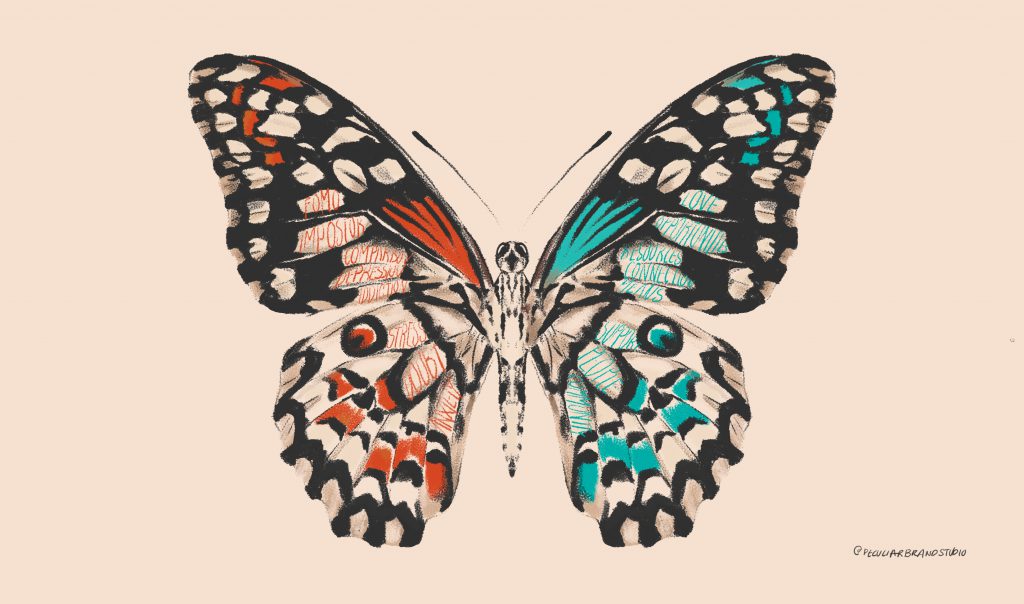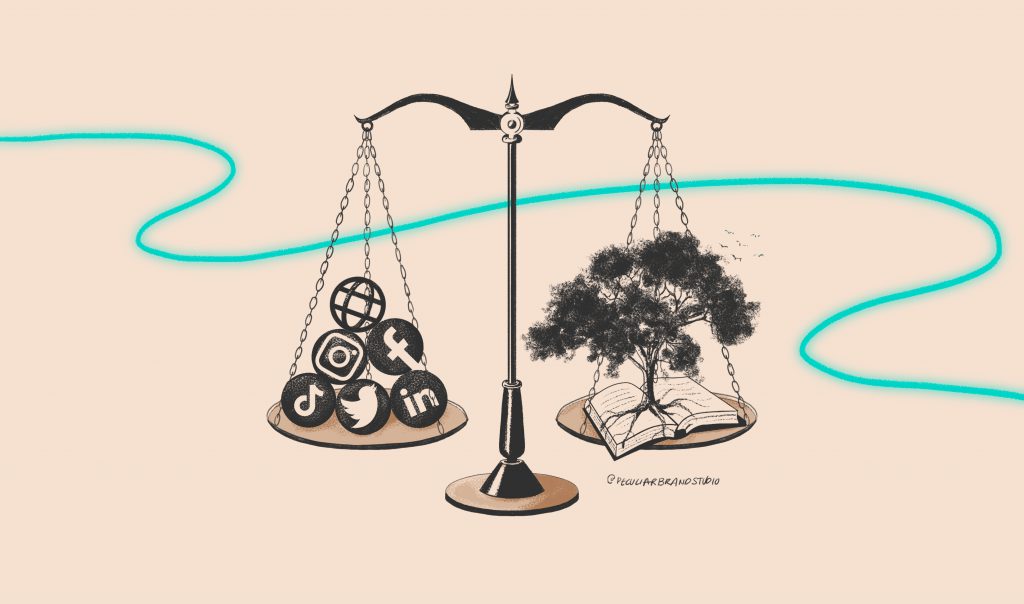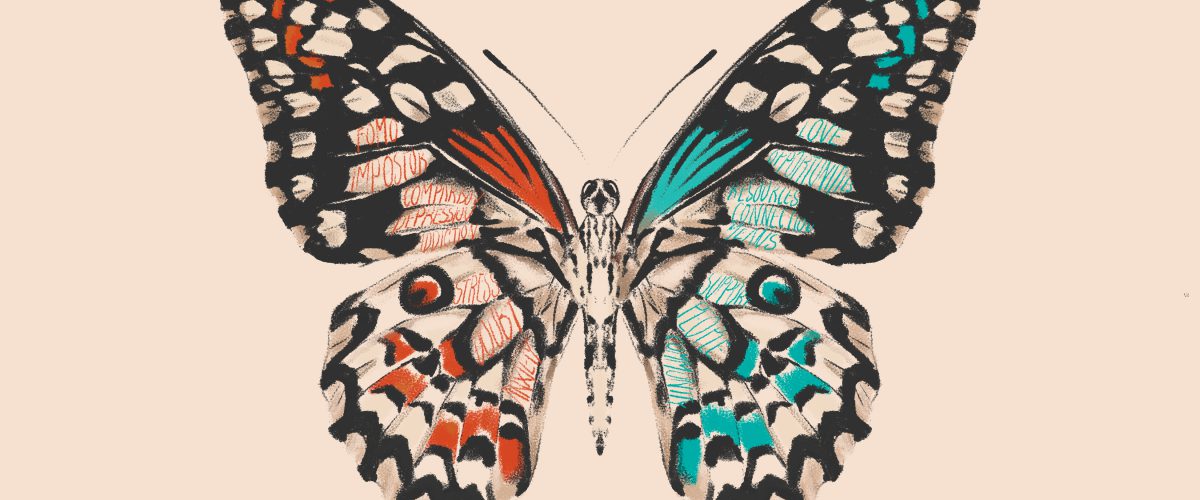I can feel your eyes rolling from reading the title. “Not again, not one more article on the terrible effects of digitalization and the unparalleled detriment to everyone’s mental health. We know.” Rest easy, you can put your eyes back on their sockets now. This is not that kind of article; I can’t promise sunshine and rainbows, but I will try my very best.
It’s a known fact that the abuse of technology, the internet, and social media has taken a huge toll on many of us. These resources can quickly become addictive, turning into a mindless routine that can leave us exposed and unaware of our own actions. The lack of restraint, regulation, and understanding of ourselves and our mental frameworks, in addition to the lack of knowledge of the platforms we operate in, leaves us vulnerable and highly susceptible to manipulation and conditioning. Especially in teens and young adults that are in the midst of discovering who they are and who they want to become, the digital space can become a tricky place to navigate. Comparison, FOMO, impostor syndrome, and self-doubt are only some of the many issues that arise from an unconscious use of technology. Paradoxically, the same technology that can lead to anxiety, self-harm depression, and even suicide has also saved countless lives by connecting people and resources. It provides its users with a space to explore who they are unapologetically, means to better oneself, access to different and contrasting opinions, a broader view and understanding of the world, and opportunities to grow and engage with like-minded individuals and organizations. In other words, the possibilities are endless.
Now, taking both sides into account, it is clear that digital platforms and tech have the potential to be both a dangerous weapon and a powerful ally. The challenge then is to discern how we, consumers and brands, lean into a positive utilization of these tools. Is there a right and wrong way to interact through them? Is there a place where we can reach a consensus on best practices?

When we welcomed the arrival of the Internet and particularly that of social media, we entered a new era. A new era where the way we interact with each other, the way we learn, connect, grow and evolve has forever changed. We have replaced physical spaces with entire virtual words; hugs, kisses, and applause with likes and shares; books with videos; reels and TikToks… Today, going to the cinema can now be cataloged as #vintage, and even sending an email almost seems like something of a romantic nature, when you can just send a text or WhatsApp.
Personally, I am and always will be the biggest fan of paper, offline life, slow living, and unplugging. But, that said, I’m also 100% in for remote working, self-learning, memes, endless digital resources, and access to an infinite network of humans from the comfort of my home. I firmly believe there is space within a person, a brand, an industry, and society to love and appreciate both, and it’s actually here where I want to shine the light on. If History has taught us something is that nothing is black or white, technology is not the source of all evil and the sole cause of over 264 million humans across the globe suffering from depression as it is neither the holy grail of humanity. It is time we finally learn to find balance and middle ground in both our beliefs and actions. If you don’t want to take the word of a millennial for it, Aristotle said it first and best when he stated that virtue consists of finding an appropriate middle ground between two extremes. Nobody wants to go back to the cave (I bet someone does but that’s a story for another day) and I don’t believe we are ready to become digital pixels uploaded to a cloud just yet. To this end of finding a middle ground and leaning towards the light, let’s take a look then at where we are right now.
From the moment the world went online we’ve been exposed to the biggest number of fundamental changes in the shortest period of time in History. The world continues to speed up at an exponential rate when as individuals we still have Neanderthal tendencies. There is a tremendous gap between the knowledge we have of the exterior world and how little we comprehend our own internal systems. The number of stimuli we are constantly being exposed to through the digital space has our hypothalamus feeling like fireworks 24/7. This overstimulation triggers our fight or flight systems over and over again, concluding in us becoming addicted to a state that is not natural to us. Stress is a response to a threat that is meant to pass shortly, now it’s the default mode of many. As such, we’ve lost our ability to distinguish between threats and things merely screaming for our attention, which brands are partially responsible for with the continuous bombarding of advertisements. It’s a constant fight that has caused deep wounds in the mental health and physical state of many. As if managing this wasn’t enough, to further test our ability to adjust to the unexpected and take our minds and bodies to the limit, we have now been introduced to a new commanding chief that has yet again changed the game for good, enter COVID-19.

We’ve all heard it a thousand times “Welcome to the new normal, the game has changed, get used to it”. And, yes, change is a natural and inevitable part of life we must accept and embrace, and human resilience and adaptability are to be praised but that does not mean it comes without its struggles and challenges. And well, if we can all agree on something is that COVID is a hell of a challenge. However, with every challenge, there is also massive opportunity.
This virus has spread like wildfire and with it anxiety, depression, stress, loneliness, uncertainty, vulnerability, and fear. We could stop here and just acknowledge this but at the same rate that the dark side has grown so has the light. We’ve seen creativity explode within the confinement of four walls, ideas come to life that would have never emerged if not for the adversity we are facing, neighbors coming together when before they didn’t even know each other, countries leaving their differences aside to put their minds to the same goal… We were going so fast that any sense of control and perspective that we once had, had been lost. Just like looking through a window from inside a speeding car, our vision had become blurred and skewed. Now, the brakes have been pulled on us, we’ve been forced to stop, to lay still, to wait, to change our rhythm, to listen. We were so caught up in doing all the talking, in becoming the projections of what we wanted to be perceived as, in the senseless noise of it all, that we forgot to listen. We’ve forgotten how to listen. How grand, don’t you think?
Never before has the entire human race been affected by something that literally stopped the world all at once. Even if there have been pandemics, wars and diseases already that affected a great percentage of the world’s population, it is certainly the first time that we have all gone through it together. We’ve been connected in the distance thanks to technology, we’ve been able to stay in touch, to reach out, to ask for help, to entertain ourselves, to create, to dream, and again to learn. This is where I believe the opportunity lies. We are, whether we like it or not, together in this. We’ve all gone through the same things at the same time and it’s in all of us to make the “new normal” something far greater than what we previously had. There is no turning back and, even if it were, we shouldn’t, we humans are made to go forward. We have the chance to make things right this time, to learn from our mistakes, to assess what wasn’t working, and to embrace the things that did work. To this end, technology can become a great asset for brands in the fight for a better mental health environment and a more connected world.

Finally, let’s recap and take a look at how we can create a more balanced space for mental health in the context of technology from a brand’s viewpoint:
- First and foremost, as consumers and brands, we must remember that technology is by definition invented to solve problems. If it is damaging, then we need to rethink the system. As previously stated in this article, technology is, after all, a tool and as such, it can be used for both good and bad, we all have a responsibility to make it so that we understand the effects of our interactions and actions instead of operating with it unconsciously.
- Mental Health. “Mental health includes our emotional, psychological, and social well-being. It affects how we think, feel, and act. It also helps determine how we handle stress, relate to others, and make choices.” It’s not something small, we cannot look to the other side, it is very much real and crucial as it affects everything we do. Just by openly talking about it on the different platforms and acknowledging the tricky relationship we still have with digital platforms we are already doing a lot of good; we are creating space for these conversations to be had. The aim is not to have all the answers: we are in the midst of the whirlwind, so we lack the perspective to have a proven method. But the least we can do is not to turn our heads on the matter and instead be courageous enough to show up even if we make mistakes.
- One of the greatest things about digital and online platforms is that it creates the space for people from different backgrounds and locations to come together. Let’s learn from those that are ahead of us and reach out so we can do better. Let’s leave competition to the side for a minute and ponder on the idea of how a world of collaboration would look like. From where I stand it definitely feels like a healthier space to navigate.
- Long gone are the days of pyramidal hierarchies, dictatorship in the workplace, 9.5 desk jobs, and being in the same enterprise for 20 years. New generations need something more than a paycheck, they want to be involved in making a positive impact. They want to feel connected and part of something larger. They are aiming to work remotely, travel, and be free of physical constraints. The dynamics are changing and technology is going to be in the center of it all.
- Stop what you are doing, regroup and reassess and do it often. We have the chance to do so now. We have the opportunity to be part of building something from the ground up that is sustainable emotionally, professionally, and financially. Let’s not get cough up in the noise again, and instead let’s create space inside our organizations to allow for silence and stillness. Silence, unplugging, and tuning in with ourselves does wonders for creativity and our mental health. Striving to reach that virtuous middle ground between hassling and slow-working is going to be imperative to have a sustainable and efficient mental framework.
- As brands and businesses, we need to start listening again. I don’t mean listening with a marketing goal in mind but truly listen to what is happening inside and outside of our walls. Send unbiased and anonymous surveys to your workers, ask for honest feedback from your audience, ask them to be involved… Don’t assume what people think or feel, instead ask. Technology allows us to create a space to talk and share without feeling intimidated or judged, we must use that to everyone’s advantage.
- Speak up. As consumers, we are not content with buying something pretty or functional anymore. We want and need to know what our money is supporting and what we are standing for. Social media is key here. It may not seem like it but speaking up can have tremendous beneficial effects on mental health. It helps to achieve a sense of community and belonging within the business and also with the consumers. Belonging somewhere and feeling proud about it gives a greater sense of purpose and immediately suppresses loneliness and self-doubt. We want to know what you are for and what you are against. If you have a voice you must use it.
- The world is constantly changing, every second a new idea is coming to the surface and in response, new solutions and systems must be created. Software and technology are leading the game and, as brands, we need to get on board. Find creative ways to use technology that doesn’t only focus on ads and marketing. Social media was created to build relationships, let’s not forget that behind all those numbers there are people.
- Brands have a huge role to play in shaping the future. Taking risks for what is right is something we must do. We have the power to do things better, shape minds, and create a better tomorrow. So let’s lead and inspire to do so.
- Let’s learn from History, from others, from our own mistakes, and let’s focus on being better one step at a time.
There is of course so much more we can all do to make this world of ours safer and healthier. But at the core, it all stems from the same thing: we are together in this, my fight is your fight, alone we can go quick but together we will go far. In my humble opinion, technology should be used to bring us together and not to divide us further apart. Keeping this in mind while using our platforms to first listen and then speak up, I believe sets us on the right path. Perhaps we aren’t at sunshine and rainbows nor have we reached the virtuous middle yet but at the very least the storm has come and we have great ground to plant our seeds. For now, let’s just keep bringing in the light and I’m sure rainbows will come in the aftermath.


